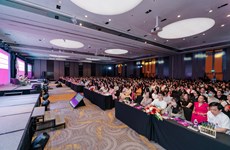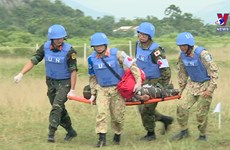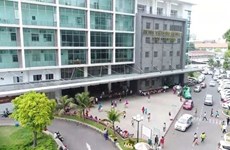Vietnam, Japan study dioxin effects on infants
Dioxin levels in the milk of first-time mothers living near the
heavily-contaminated Bien Hoa airport in southern Dong Nai province have
been found to be higher than levels recorded in other regions.
Dioxin levels in the milk of first-time mothers living near the
heavily-contaminated Bien Hoa airport in southern Dong Nai province have
been found to be higher than levels recorded in other regions.
This is the initial result of research jointly conducted by doctors from Japan’s Kanazawa Medical University and the Dong Nai provincial Health Department, which was unveiled at a workshop in Hanoi on May 8.
According to the Dong Nai Association of AO/dioxin Victims, US troops stored more than 98,000 barrels of chemicals containing 205 litres of dioxin at Bien Hoa airport, which once served as their airbase during the war in Vietnam .
Between December, 1969, and March, 1970, at least four leaks of the toxic defoliant kept at the airport were reported, releasing 25,000 litres into the earth, which resulted in a higher-than-permitted level of dioxin contamination.
Under the study, blood samples and umbilical cords from more than 200 one-month-old infants born in 10 wards surrounding Bien Hoa airport have been tested since September, 2012.
When the infants were six months old, their neurodevelopment and their mothers’ milk were also tested.
The study found that the level of dioxin in first-time mothers’ milk increased with their ages.
A number of premature babies were recorded. These babies gained weight slowly in their first month.
A representative of Kanazawa Medical University said the doctors in the study will follow these babies until they are 2 years old.
In the coming time, the two sides will work together to study dioxin exposure through food in Bien Hoa city, as over 90 percent of dioxin gets into the human body through fish and animal milk-sourced products.
At the workshop, results of dioxin studies conducted in two districts in central Da Nang city were presented.-VNA
This is the initial result of research jointly conducted by doctors from Japan’s Kanazawa Medical University and the Dong Nai provincial Health Department, which was unveiled at a workshop in Hanoi on May 8.
According to the Dong Nai Association of AO/dioxin Victims, US troops stored more than 98,000 barrels of chemicals containing 205 litres of dioxin at Bien Hoa airport, which once served as their airbase during the war in Vietnam .
Between December, 1969, and March, 1970, at least four leaks of the toxic defoliant kept at the airport were reported, releasing 25,000 litres into the earth, which resulted in a higher-than-permitted level of dioxin contamination.
Under the study, blood samples and umbilical cords from more than 200 one-month-old infants born in 10 wards surrounding Bien Hoa airport have been tested since September, 2012.
When the infants were six months old, their neurodevelopment and their mothers’ milk were also tested.
The study found that the level of dioxin in first-time mothers’ milk increased with their ages.
A number of premature babies were recorded. These babies gained weight slowly in their first month.
A representative of Kanazawa Medical University said the doctors in the study will follow these babies until they are 2 years old.
In the coming time, the two sides will work together to study dioxin exposure through food in Bien Hoa city, as over 90 percent of dioxin gets into the human body through fish and animal milk-sourced products.
At the workshop, results of dioxin studies conducted in two districts in central Da Nang city were presented.-VNA













